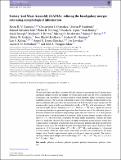Galaxy And Mass Assembly (GAMA) : refining the local galaxy merger rate using morphological information
Abstract
We use the Galaxy And Mass Assembly (GAMA) survey to measure the local Universe mass-dependent merger fraction and merger rate using galaxy pairs and the CAS (concentration, asymmetry, and smoothness) structural method, which identifies highly asymmetric merger candidate galaxies. Our goals are to determine which types of mergers produce highly asymmetrical galaxies and to provide a new measurement of the local galaxy major merger rate. We examine galaxy pairs at stellar mass limits down to M* = 108 M⊙ with mass ratios of <100:1 and line-of-sight velocity differences of ΔV < 500 km s−1. We find a significant increase in mean asymmetries for projected separations less than the sum of the individual galaxy's Petrosian 90 radii. For systems in major merger pairs with mass ratios of <4:1, both galaxies in the pair show a strong increase in asymmetry, while in minor merger systems (with mass ratios of >4:1) the lower mass companion becomes highly asymmetric, whereas the larger galaxy is much less affected. The fraction of highly asymmetric paired galaxies which have a major merger companion is highest for the most massive galaxies and drops progressively with decreasing mass. We calculate that the mass-dependent major merger fraction is fairly constant at ∼1.3–2 per cent within 109.5 < M* < 1011.5 M⊙, and increases to ∼4 per cent at lower masses. When the observability time-scales are taken into consideration, the major merger rate is found to approximately triple over the mass range we consider. The total comoving volume major merger rate over the range 108.0 < M* < 1011.5 M⊙ is (1.2 ± 0.5) × 10−3 h370 Mpc−3 Gyr−1.
Citation
Casteels , K R V , Conselice , C J , Bamford , S P , Salvador-Sole , E , Norberg , P R , Agius , N K , Baldry , I , Brough , S , Brown , M J I , Drinkwater , M J , Driver , S P , Graham , A W , Bland-Hawthorn , J , Hopkins , A M , Kelvin , L S , Lopez-Sanchez , A R , Loveday , J , Robotham , A S G & Vazquez-Mata , J A 2014 , ' Galaxy And Mass Assembly (GAMA) : refining the local galaxy merger rate using morphological information ' , Monthly Notices of the Royal Astronomical Society , vol. 445 , no. 2 , pp. 1157-1169 . https://doi.org/10.1093/mnras/stu1799
Publication
Monthly Notices of the Royal Astronomical Society
Status
Peer reviewed
ISSN
0035-8711Type
Journal article
Description
KRVS acknowledges the Science and Technology Facilities Council (STFC) for providing funding for this project, as well as the Government of Catalonia for a research travel grant (ref. 2010 BE-00268) to begin this project at the University of Nottingham. PN acknowledges the support of the Royal Society through the award of a University Research Fellowship and the European Research Council, through receipt of a Starting Grant (DEGAS-259586).Collections
Items in the St Andrews Research Repository are protected by copyright, with all rights reserved, unless otherwise indicated.
Related items
Showing items related by title, author, creator and subject.
-
SDSS-IV MaNGA: How the stellar populations of passive central galaxies depend on stellar and halo mass
Oyarzún, Grecco A.; Bundy, Kevin; Westfall, Kyle B.; Tinker, Jeremy L.; Belfiore, Francesco; Argudo-Fernández, Maria; Zheng, Zheng; Conroy, Charlie; Masters, Karen L.; Wake, David; Law, David R.; McDermid, Richard M.; Aragón-Salamanca, Alfonso; Parikh, Taniya; Yan, Renbin; Bershady, Matthew; Sánchez, Sebastián F.; Andrews, Brett H.; Fernández-Trincado, José G.; Lane, Richard R.; Bizyaev, D.; Boardman, Nicholas Fraser; Lacerna, Ivan; Brownstein, J. R.; Drory, Niv; Zhang, Kai (2022-07-06) - Journal articleWe analyze spatially resolved and co-added SDSS-IV MaNGA spectra with signal-to-noise ratio ∼100 from 2200 passive central galaxies (z ∼ 0.05) to understand how central galaxy assembly depends on stellar mass (M*) and halo ... -
Secular-and merger-built bulges in barred galaxies
Mendez Abreu, Jairo; Debattista, V. P.; Corsini, E. M.; Aguerri, J. A. L. (2014-12) - Journal articleContext. Historically, galaxy bulges were thought to be single-component objects at the center of galaxies. However, this picture is now questioned since different bulge types with different formation paths, namely classical ... -
Galaxy And Mass Assembly (GAMA) : galaxy close pairs, mergers and the future fate of stellar mass
Robotham, A. S. G.; Driver, S. P.; Davies, L. J. M.; Hopkins, A. M.; Baldry, I. K.; Agius, N. K.; Bauer, A. E.; Bland-Hawthorn, J.; Brough, S.; Brown, M. J. I.; Cluver, M.; De Propris, R.; Drinkwater, M. J.; Holwerda, B. W.; Kelvin, L. S.; Lara-Lopez, M. A.; Liske, J.; Lopez-Sanchez, A. R.; Loveday, J.; Mahajan, S.; McNaught-Roberts, T.; Moffett, A.; Norberg, P.; Obreschkow, D.; Owers, M. S.; Penny, S. J.; Pimbblet, K.; Prescott, M.; Taylor, E. N.; van Kampen, E.; Wilkins, S. M. (2014-11-11) - Journal articleWe use a highly complete subset of the Galaxy And Mass Assembly II (GAMA-II) redshift sample to fully describe the stellar mass dependence of close pairs and mergers between 10(8) and 10(12)M(circle dot). Using the analytic ...

